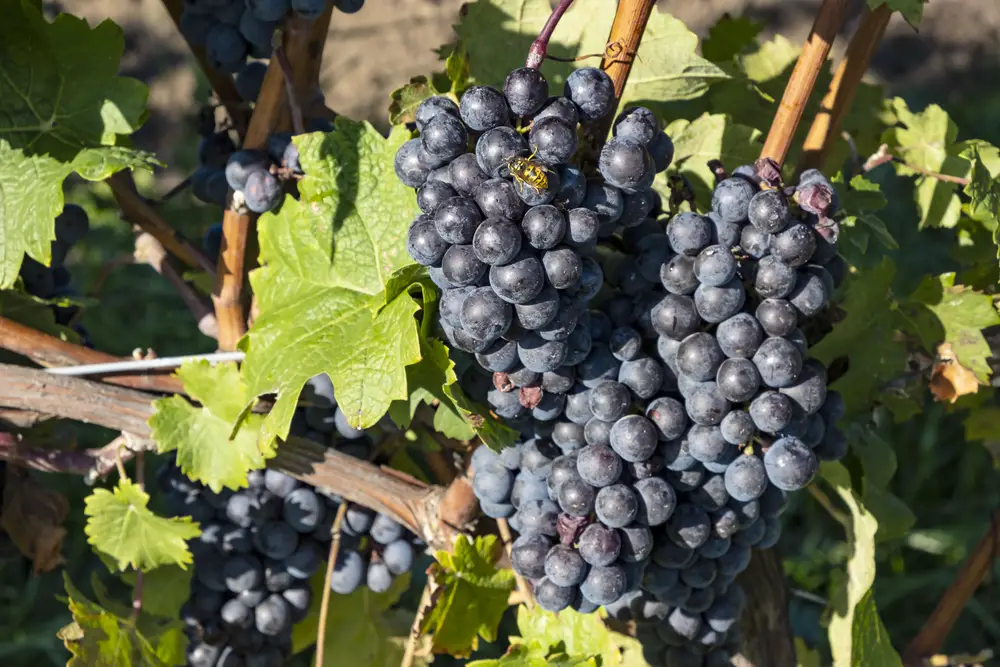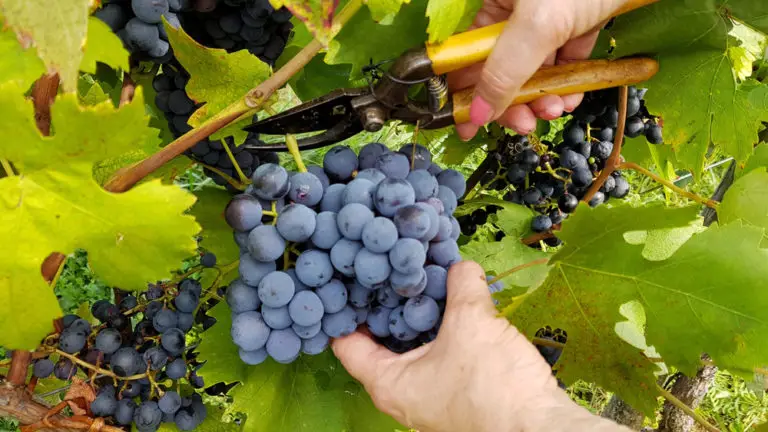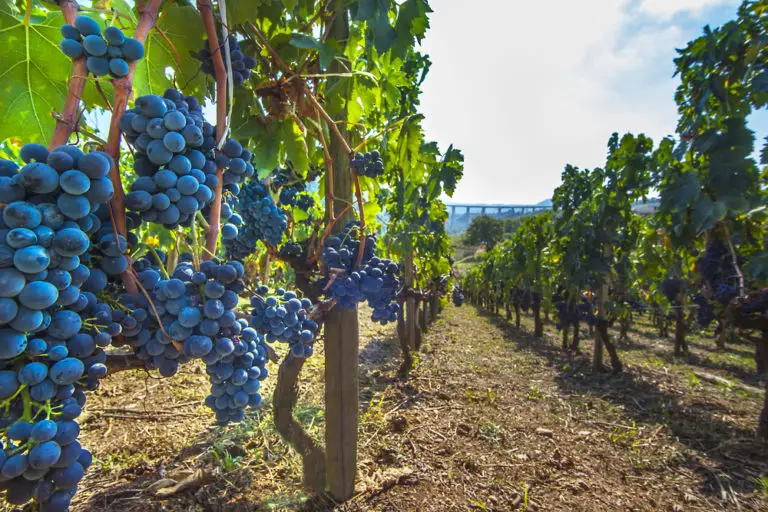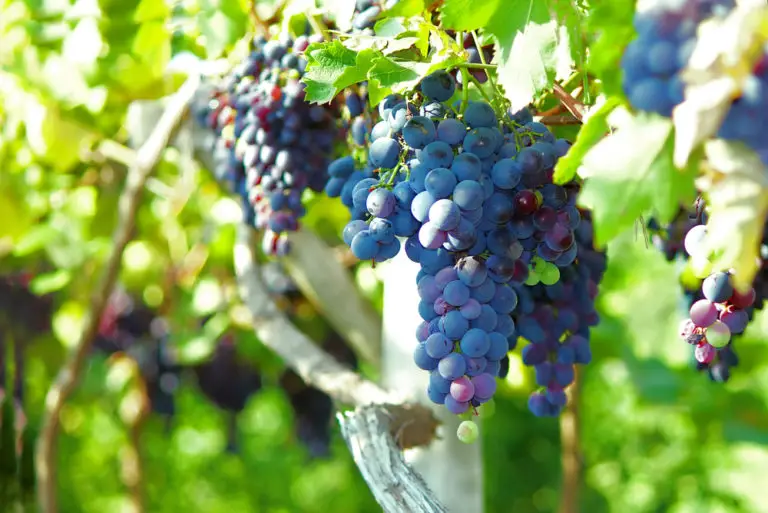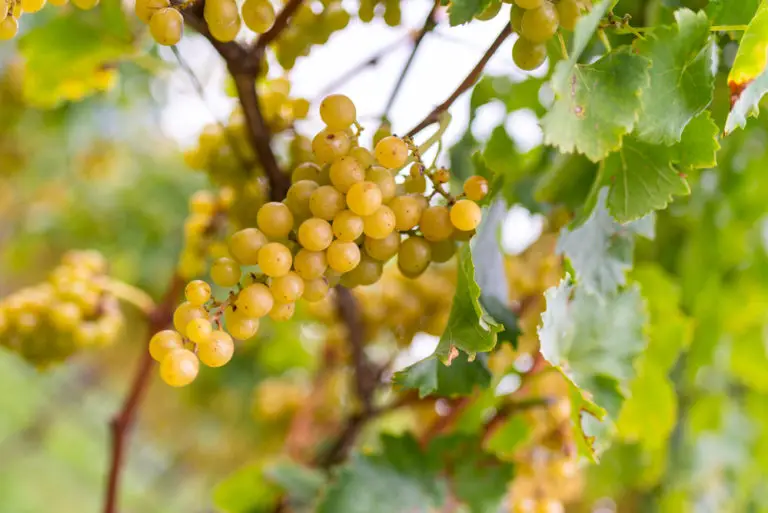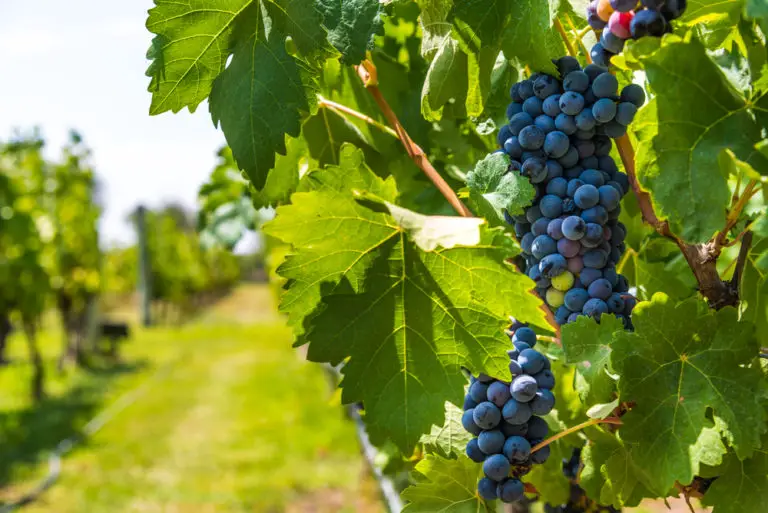Cabernet Franc: The Beginners Guide (2024)
Cabernet Franc is one of the most widely grown grape varieties around the world. It is believed to be derived from wild grapes and has been cultivated in France for several centuries.
It delivers less powerful, lighter wines with lesser bouquets and bodies. The grape is particularly used in creating cuvées and is rarely developed as a pure varietal wine.
Wine Color: Bright pale red
Characteristics: Lower tannin, acidity, light color
Color of berry skin: Blue Black
Flavor: Dry
ABV: 11.5–13.5%
Origin: France
Notable Regions: Bordeaux, Loire, Friuli, Sonoma, and Napa Valley regions
Most Expensive Bottle: Screaming Eagle Cabernet Franc 1992
Common synonyms: Bordo, Bouchet, Bouchy, Breton, Cabernet Franco, Cabernet Frank.
- What is Cabernet Franc?
- Known Regions for Cabernet Franc
- Popular Blends of Cabernet Franc
- How to Enjoy Cabernet Franc?
- How is Cabernet Franc Made?
- History of Cabernet Franc
- Alternatives for Cabernet Franc
What is Cabernet Franc?
The Cabernet-Franc grape originated from a natural cross of wild vines and can boast of being the father of two great grape varieties: Cabernet Sauvignon and Merlot.
These blue-blacks, almost purple grapes are often blended to make Bordeaux wines. So it’s no wonder that one of the largest growing areas in France can be found there.
However, the best-known single-variety wines come from the Loire. Cabernet Franc pronunciation is ka·buh·nay·frangk.
Cabernet Franc has been grown there for centuries. It is documented that Cardinal Richelieu personally campaigned for the cultivation of the red grape variety on the Loire in the 17th century. Other important growing areas are in Spain and Italy, especially in Friuli. But the vine has also gained a foothold overseas.
The pure varietal wines of the Cabernet Franc are among the best original red wines in France. In its home country on the Loire, it is still mainly matured in wooden barrels and matured in dark vaulted cellars towards its perfection.
Cabernet Franc vs. Cabernet Sauvignon vs. Pinot Noir
Cabernet Sauvignon is a natural cross between the Cabernet Franc × Sauvignon Blanc varieties. The red wine variety started its triumphal march all over the world from Bordeaux in France. The skin of the Cabernet Franc grape is thinner than Cabernet sauvignon. It makes Cab Franc lower in tannin and lighter in color. Also, it ripens a week earlier than Cab Sauv and is grown in slightly cooler climates. They both cabernet franc vs cabernet sauvignon have herbaceous notes reminiscent of green bell pepper and red fruit aromas, making them similar.
The Cabernet Franc profile is very similar to Pinot Noir, but they have their differences. Both are dry red wines having a medium body, medium-high acidity, and 11.5-13.5% abv. When it comes to tannins, Cabernet Franc has more tannins when compared to Pinot Noir. Also, their primary flavors vary from each other, Pinot Noir is fruitier having notes of Cherry, raspberry, vanilla, and mushrooms.
Cabernet Franc Characteristics
Cabernet Franc is considered a grape variety that copes well with many climatic and soil conditions. It drives out medium late so that it is hardly endangered by spring frosts.
Its flowering and maturity, which is around a week earlier than Cabernet Sauvignon, is particularly popular with Bordeaux winemakers as a kind of insurance: if some of the Cabernet Sauvignon grapes are damaged shortly before the harvest, winemakers will turn to the Cabernet Franc grapes, which are often less damaged due to their slightly shifted vegetation rhythm.
Due to its relatively early ripeness, the Cabernet Franc grape can also be cultivated in relatively cool climates. Like Riesling or Pinot Noir, it is one of the so-called Cool Climate varieties. However, it does not depend on this weathered zone and thrives well in warm climates.
The grapes of the Cabernet Franc vine are medium-sized and covered with small, blue-black berries. These only have relatively thin skin, which explains why the wines from this variety have a light Cabernet Franc color and taste little tannin.
Cabernet Franc Taste Profile
Cabernet Franc descriptors often compare the character of Cabernet Franc with that of Cabernet Sauvignon – it is the most famous relative and the most important partner in the Bordeaux region.
The aromas of different types of Cabernet Franc are mainly reminiscent of raspberries, red and black currants, violet blossoms, pepper, herbs, and sweet tobacco. There are also fine notes of other spices such as vanilla, cinnamon, or aniseed. Cab Franc wine from cooler regions also shows slight hints of vegetable aromas such as grass or green peppers.
The red wines of this grape variety are ruby red in the glass and the Cabernet Franc has a rather low astringency and a lower tannin content. It is vinified into pleasant, juicy red wines with a good body, which brings an extraordinary taste experience with them.
The Cabernet Franc flavor profile is known for its typical raspberry aroma. In addition, aromas of currant leaves as well as strawberries, licorice, and violets can often be found in the red wines of this grape variety.
Cabernet Franc Ageability
The maturation of wine is the correct term for what is commonly defined aging of wine, that phase of refinement that takes place before its bottling.
The maturation of a wine is the period necessary for the wine to harmonize its components. In fact, at the end of the pure vinification phase, the sugar, due to the effect of the yeasts, is transformed into alcohol and the secondary aromas have developed.
However, the wine is still immature, rich in sharpness and young and sour flavors. For a young red wine and drinkable, the minimum period is about three months, in inert containers (steel, fiberglass, or concrete).
For more structured wines, it is often chosen to let much longer periods pass, up to 4 or 5 years, in wooden containers, which can be large or small. The large barrel behaves like an inert container, even if more natural, while the small barrels also have the function of transferring tannic substances to the wine.
Cabernet Francs can lay down in the cellar for 10-15 years.
Notable Regions for Cabernet Franc
With around 55,000 hectares of global stocks, Cabernet Franc is among the top 20 most cultivated grape varieties in the world.
About 70 percent of the world’s Cabernet Franc stocks are in their home country. Italy also has extensive Cabernet Franc cultures.
In Germany, on the other hand, there are only some plantings – just 16 hectares are under the Cabernet Franc name. Let us look into more details:
France
Today, France cab on the Loire thrives particularly well in the region between Angers and Tours. In the southwest of France, Cabernet Franc is increasingly grown in the Dordogne and Gironde. There are also larger plantings in the Lot-et-Garonne, Lot, and Quercy departments. A total of almost 39,000 hectares are planted with Cabernet Franc in France today.
Italy
The variety came here at the beginning of the 19th century and is now mainly grown in the northeast part of the country, in the regions of Veneto and Friuli. Here, it is mostly made of a single variety: In addition to high-quality, full-bodied Italian cabernet franc, there are also many medium-heavy and numerous light red wines from this variety.
Hungary
Cabernet Franc varietal in Hungary attracted attention in the late 1990s when in some wine-growing areas, the climate and growing conditions were not optimal for Cabernet Sauvignon to reach full maturity. The variety here is a typically full-bodied, moderately or heavily tannic wine with rich aromas of spices, blue flowers, and red/blackberries with a reasonably good aging potential of around ten years.
Canada
Increasingly popular in Canada, Cabernet Franc is planted in Ontario’s Niagara Peninsula, Prince Edward County, the north shore of Lake Erie, Pelee Island, and the Okanagan Valley in British Columbia. While it’s most commonly used in blends, it’s growing in popularity as a single variety and as ice wine. Ontario Cabernet Francs often give a wine with moderate acidity a characteristic vegetable, raspberry-like taste.
Other European Regions
Outside France and Italy, there are significant plantings in the Cabernet Franc region, like Greece, Bulgaria, Slovenia, and Croatia, particularly in the Savudrija part of Istria, Croatia. This grape variety is not very common in Spain and is mainly grown in Catalonia, where it is approved in four DOPs: Catalunya (DO), Costers del Segre, Empordà, Pla de Bages, and Priorat.
Popular Blends of Cabernet Franc
The Cab Franc grape is very often found in high-quality cuvées, for which it is assembled with Merlot and Cabernet Sauvignon.
Cabernet Franc mainly brings spicy aromas and tartaric acid into these cuvées, as well as pleasantly structured tannins.
This grape variety can also be mixed with other expressive varieties, such as Malbec, Tannat, and Fer Servadou. Here are some Cabernet Franc blends:
Château Ksara Reserve du Couvent 2018
The Château Ksara Reserve du Couvent 2018 is an exceptional wine that combines the best grape varieties. The red wine consists of the grape varieties; 40% Syrah, 30% Cabernet Franc abv, 30% Cabernet Sauvignon. All high-quality grapes that together make a powerful and full red wine: the Reserve du Couvent 2018. When tasting this wine, a true taste experience awaits you.
Karas Classic Red Dry 2018
This wine is an interesting mix of four grape varieties – Cabernet Franc, Cot, Syrah, and Tannat. This elegant wine has an intense ruby red Cabernet Franc wine color and fruity aromas of blackberries and red fruits. The very tannin-rich Tannat in this red dry wine is softened in this blend with Cabernet Franc, which results in making a structured wine with great acidity.
Howell Mountain Cabernet Franc 2010
This wine is a mixture of the four classic Bordeaux varieties. This blend gives the tannic signature commonly associated with the Howell Mountain appellation. On the palate, you can enjoy classic Howell Mountain Flavors with blackberry, slate, earth, rosemary, and espresso beans. It has 94% Cabernet Franc alcohol percentage and 6% Cabernet Sauvignon.
Vegan A16 Blend Punto Ar from Mendoza, Argentina
The wine has a brilliant and intense red color and is the perfect blend between Cabernet Sauvignon and Cabernet Franc alcohol content. It has an intense aroma of sweet pepper, tobacco, cassis, and coconut; everything is perfectly and harmoniously balanced. It pairs well with dark meat, pasta, pizza, beef tenderloin, beef, and red meat.
Cabernet Franc 2018 – El Enemigo
This cuvée is made from a composition of plots located at an altitude of over 1400 meters. A crunchy mixture of blueberries and black currants caresses the nose, enveloped in the sweetness of fine spices and subtle wood cab franc tasting notes. The coming together of a velvety, spicy black fruit and freshness, carried by strong tannins that promise excellent aging potential!
How to Enjoy Cabernet Franc?
Wine can taste awfully different, if it is not drunk at the right temperature, with the proper food pairing or stemware. They are all responsible for accentuating the Cabernet Franc flavor and aroma. Here are some of the wine recommendations for Cabernet Franc that make it more interesting to drink.
Food Pairings
Cabernet Franc wines are good food companions, and due to their harmonious nature go well with a variety of dishes. With its fruity-peppery aroma, which often also contains hints of fine herbs, Cabernet Franc wine goes very well with dishes that are seasoned or prepared with the appropriate ingredients.
Therefore, you should choose the right dishes according to the respective Cabernet Franc wine ingredients: As a component of Bordeaux cuvées, a glass of Cabernet Franc goes very well with roasted beef steak or fillet as well with a fine veal ragout seasoned with herbs.
Light single varietal Cabernet Franc wine pairing is ideal with pasta with a red sauce prepared, for example, based on tomatoes and peppers. Dishes with rather lean meat, sauteed vegetables, and a light sauce are also good choices for such types of wine.
Spicy mushroom sauces or grilled mushrooms, on the other hand, make a nice addition to a medium-heavy Cabernet Franc in autumn.
Temperature
With the right temperature and depending on the variety, red wine develops identifying features such as tannins, alcohol, and many facets.
However, if it is served too cold, tannins quickly become bitter – while alcohol creates an overly dominant impression at too high a temperature.
The truth lies in the middle with red wine. In addition, the specific temperature should also be selected depending on the character of the respective drop.
As far as the drinking temperature is concerned, the following generally applies: the heavier the red wine, the higher the temperature at which it can be drunk.
Nevertheless, even for the heavyweights among the Reds, the average room temperature is too high. It is usually quite a bit above the 20 degree Celsius mark. So you can cool down every red wine a bit without damaging the taste experience.
The ideal temperature to drink Cabernet Franc is 60 degrees Fahrenheit (16 degrees centigrade).
Stemware
Using the right glass of quality wine will allow you to better taste the nectar of the wine and have an optimal perception of the Cabernet Franc characteristics. You don’t necessarily have to be a sommelier to drink a good glass of red wine: making a careful choice of glass is essential, just pay attention to some main characteristics, which we will now discover:
Stölzle Lausitz Red Wine Glasses
The modern design glasses are ideal for those who love square lines and a flat base. Made of lead-free cut crystal, thanks to their particular shape they allow excellent oxygenation of the wine and bring out the aromas.
Spiegelau Calici da Bordeaux Willsberger
These glasses have a shiny edge, wide belly, and thin stem that allows you to oxygenate every wine from Bordeaux to Burgundy in the best possible way, enhancing the aromas and fragrances of the wine.
Rod Wine Red Wine Glasses
The crystal goblets made with eco-sustainable techniques are reinforced with titanium. These glasses with a large belly allow better oxygenation while retaining all the aromas.
How is Cabernet Franc Made?
Knowing the stages of Cabernet Franc winemaking is necessary to understand. From harvesting to bottling, every stage is important. Here are the preparation steps to give life to one of the pleasures of the table. It is mostly the same for all red wines, except for minor changes that depend on the different winemakers.
Harvesting
It is correct to say that the vinification begins before picking the grapes from the vine, as the care of the vine requires attention from the cultivation with specific products. When ripening is complete, the grapes are harvested from the Cabernet Franc vineyard. In this phase, the healthy bunches are selected, separating them from those with mold or those still unripe.
Crushing
The vinification begins with the pressing and ends with the alcoholic fermentation process. This process transforms the sugar and water of the grape into Cabernet Franc alcohol and carbon dioxide. The crushing is usually performed with special machines capable of crushing the grapes and discarding the stalks. Consequently, the must, which increases in volume during fermentation, is pumped into the vat until it is filled to three-quarters.
Fermentation
When the must is in the vat, the fermentation phase begins. To keep this phase under control, selected yeasts are introduced into the must, which is activated separately in a part of the must which will then be combined with the rest. At this point, the so-called cap is formed through the fermenting must, which releases gases that push the pomace upwards.
Aging
Wine is removed from the vat using an electric pump and placed in a clean barrel. While the wine is in wooden barrels or steel containers, the fermentation takes place slowly for about a month until it reaches complete exhaustion, and the wine will block the phase in which it expresses the “fizz.”
Bottling
Once the wine reaches its maturity, it is bottled and stored in a cool place all year round. It is kept at a temperature of about 15 °, in the dark, with low humidity and away from harmful odors such as petrol. For about ten days the bottles must stand vertically, to dilate the caps, then they can be extended.
History of Cabernet Franc
The Cabernet Franc is one of the oldest known grape varieties and is one of the most important in Bordeaux, although, here it is often overshadowed by Cabernet Sauvignon and Merlot.
Curiously, however, its origin is not in the Gironde, but in the Basque Country, from where it came to the Bordelais and the Loire. There, it is first mentioned in 1534 under the name Breton, but there are indications that it had long since found its way into the Loire in the 11th century.
By the 18th century, Cabernet Franc (known as Bouchet) were found all over Fronsac, Pomerol, and St-Emilion and made quality wines.
As Cabernet Sauvignon grew in popularity in the 18th and 19th centuries, the close similarity of the two grapes was observed and theories were suggested as to the extent of their relationship.
In 1997, DNA evidence emerged that Cabernet Franc had crossed with Sauvignon blanc to make Cabernet Sauvignon.
Alternatives for Cabernet Franc
You can get bored drinking Cabernet Franc for a longer duration. If you are a Cabernet Franc lover, but just want to try something different, yet similar then, you should try these alternatives for Cabernet Franc. They would be a great replacement for your weekend drink, this week.
Cabernet Sauvignon
Cabernet Sauvignon is a natural and spontaneous cross between the red grape variety Cabernet Franc and the white Sauvignon Blanc. Its origins lie in Bordeaux, where it has probably been known since the 17th century. For a long time, wine experts believed that Cabernet Franc was the little brother of the Cabernet Sauvignon grape.
Pinot Noir
The Pinot Noir grape is considered one of the finest in the world. Their fragrant wines inspire connoisseurs around the world. The bouquet of good Pinot Noir wines smells delicately of sweet red berries and red stone fruits. As far as the body is concerned, Pinot Noir wines show a balanced ratio of subtle sweetness and lively, sometimes higher, tartaric acid.
Merlot
Merlot is one of the most popular red wine grapes in the world. It is cultivated and expanded in all warmer growing regions. Merlot wine is a delight for the palate with round, soft tannins and wonderful fruit aromas. With a wonderful scent of currants, cherries, plums, and sweet spices such as clove and cinnamon and sometimes dark chocolate, it has a large fan base.
FAQ
Is Cabernet Franc sweet or dry?
Cabernet Franc is a dry wine with classic medium-bodied red and moderate tannins. It might taste fruity, but they don’t have any residual sugar left in the finished wine.
What does Cabernet Franc mean in English?
Cabernet Franc meaning dry red wine often used in blends (as with merlot or cabernet sauvignon). It is very robust and produces good quality wines.
Does Cabernet Franc need to breathe?
Yes, Cabernet Franc becomes softer and rich when allowed to breathe for 30 minutes. It helps the wine to simmer down its natural spiciness.
What does Cabernet Franc smell like?
100% Cabernet franc is aromatic and delicate, having fruity aromas of cherry, strawberry, and tomato. It has a lovely lightness of touch that makes it different.
What is Cabernet Franc similar to?
Cabernet Franc wine is similar to Cabernet Sauvignon. Cabernet Franc is slightly on the dry side, whereas Cab Sauv is generally dry to very dry.
What is the difference between Cabernet Sauvignon and Cabernet Franc?
Cabernet Franc is a lighter wine in comparison to Cabernet Sauvignon. It has lower tannin, acidity, and thinner skin, which contributes to the lighter color.

